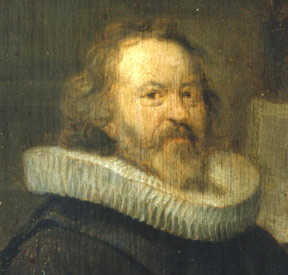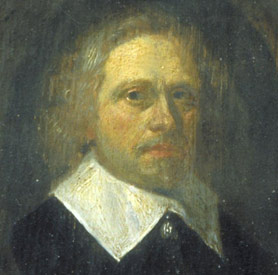History
of the Athenaeum Illustre and the Universiteit van Amsterdam
In the seventeenth century the city of Leiden had the exclusive right to hold university examinations in the province of Holland. The city of Amsterdam was unsatisfied with this state of affairs. After all, an institution of higher education increased the town’s prestige. Besides this, students began their education young, sometimes even at the age of thirteen. With this in mind, a local institution of higher education was founded, the so-called Athenaeum Illustre. Though not a university – obtaining a doctoral degree was not possible – the Athenaeum Illustre did provide thorough training. Students could then finish their education at a university in another town. The first two professors in Amsterdam, both coming from the university of Leiden, were top class: Johannes Vossius, who taught history, and Caspar Barlaeus, who taught philosophy.
 |  |
| Gerardus Joannes Vossius | Caspar Barlaeus |
Amsterdam housed several other practically-oriented institutions of higher education. The first of these was the Collegium Chirurgicum, which provided training for surgeons even prior to 1632. Other institutions provided theological courses – since 1634 for the Remonstrant community and since 1681 for Mennonites. Thanks to the relative religious freedom in Amsterdam, it was easier for these institutions to settle here. Their students regularly attended classes at the Athenaeum Illustre. The Athenaeum thus became a training center for city councillors, clergymen, well-to-do citizens and merchants in a wealthy, prospering town.
During the seventeenth and eighteenth centuries the Athenaeum Illustre had its ups and downs. In the nineteenth century it gained importance. In 1815 it received the statutory obligation “to disseminate taste, civilization and learning" as well as “to replace, at least in part, the institutes of higher education and an academic education for those young men whose circumstances unable them to fully spend the time necessary for an academic career at an institute of higher education.” In addition, the Athenaeum offered classes for students attending non-academic professional training, in particular pharmacy and surgery, since 1800. Finally, the Athenaeum Illustre worked together with theological institutions such as the Evangelisch-Luthers Seminarium (evangelical-lutheran), founded in 1816 and the Klinische School (medical school), founded in 1828 and successor to the Collegium Chirurgicum which had been discontinued in 1798.
In 1877 the Athenaeum Illustre became a municipal university. As such it possessed the same rights as national universities but was financed by the city of Amsterdam. Professors and other lecturers were appointed by the city council. This resulted in a group of people who were in many ways more colourful than their colleagues at the national universities. Once again the university flourished, in particular the science department, which counted many celebrities including several Nobel prize winners.
Another effect of the University of Amsterdam's municipal status was the relatively early addition of the faculties of Economics and Social Sciences. After the Second World War the cost of university education rose rapidly and sharply, putting a constraint on the university’s growth. As of 1961 national government took over funding from the city and appointment of professors was transferred to the Board of Governors. The city’s influence ended completely in 1971, when the appointment was handed over to the Executive Board.